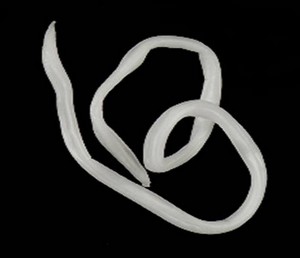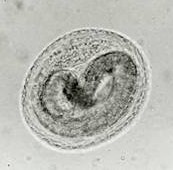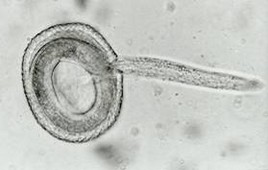BACKGROUND INFORMATION ROUNDWORM
Roundworm
Thre is a differentation between roundworms in dogs and roundworms in cats. In dogs, the name of the roundworm is Toxocara canis and in cats the name of the roundworm is Toxocara cati. Roundworms can infect humans. An adult roundworm is 7-10 cm long.
 |
Source of contamination and transmission
Adult worms live in the intestinal tract of dogs and cats and lay eggs that are transported out of the body with faeces. These eggs are not instantly infectious. Only after a a period of a few weeks to months “infectious larvae” develop in the eggs (the contamination stage) that can infect the next host. The eggs with infectious larvae are very strong resistance against environmental influences and can survive up to a year in the soil. Especially when young, sensitive dogs or cats ingest the infectious larvae, the larvae will travel to the bowels through the stomach, pass the intestinal wall in the bowel and through the blood vessels they will wander through the body. They will travel among other things, to the trachea and lungs, where they will cause irritation and are coughed up. Coughed up mucus is swallowed and the larvae enter the intestinal tract again. There they will grow to adult worms that will start laying eggs again.
In adult animals , that have built up some resistence against this type of worm infection, the larvae will get stuck in some part of the body and will stay there ins some sort of dormant stage. However, when a bitch is pregnant, these dormant larvae can be activated and reach the pups through the placenta. This way the pups are already contaminated before being born. Activated larvae can also contaminate pups and kittens right after birth, because the larvae are present in the mother’s milk. The young animals ingest the larvae that way.
Other animals like, for example, mice can also be infected with eggs. The larvae will wander through the body and get stuck somewhere. When a dog or cat eats an infected mouse, the larvae will infect them. The cycle
can be completed, with the larvae eventually ending up in the inestines of the animal where they will lay eggs that contaminate the environment.
People, especially small children, get infected by eating contaminated sand or soil. In people the eggs cannot develop to adult worms, but the larvae can wonder trough the body. (viscerale larva migrans)
Disease symptoms in humans
The round-worm mainly infects small children. The symptoms of infection are also dependent on the amount of infectious larvae the child ingested.Most infections go off without complaints. If there are complaints these symptoms are usually caused by larvae in the liver and lungs: nausea, abdominal pain, coughing. In more severe cases fever, muscle- and joint pains, vomiting and rashes can occur. Larvae that travel to the eye cause a very common complication. Often serious disturbances in the eyesight of one eye can occur. In rare cases, larvae that travel to the brain, cause epileptic attacks. There seems to be a connection between going through a Toxocara infection and the occurance of allergic asthma, Toxocara infections can probably worsen the symptoms of asthma.
Disease symptoms in animals
Adult cats and dogs that ingest a small amount of contaminated eggs normally will not get sick. Infected pups and kittens will often have diarrhoea, vomit, have a “ pot-bellied “ appearance and are less fit. If there are a really large infestation of worms in the intestines, the intestines can even rupture and the animal will die. Pups that have been infected before birth, will sometimes cough and display symtoms of pneumonia.
Spreading of infection
Blood tests showed that 19% of the Dutch population has been into contact with Toxocara at some point in time.This is not so surprising because infection among animals is very common. It is estimated that all Dutch puppies are born with a Toxocara infection (puppies were infected in the womb). Of all adult dogs 5 to 10% are carriers of round-worm and secrete eggs. A study of sandboxes in Utrecht found contaminated eggs in approximately 50% of the inspected sandboxes.
 |
| Roundworm egg |
 |
| Roundworm egg A larvae crawling from a roundworm egg. The larvae is approx. 1/3 mm big. |
Prevention roundworm
It is advisable to worm your adult pets four times a year with a de-worming formula that kills eggs, larvae and hookworms in all stages of development. These are called broad spectrum de-worming medication. Young animals need to be wormed more often. Sandboxes need to be closed off so no dogs or cats can defecate in them. Furthermore personal hygiene is of course important. Wash your hands toroughly with water and soap after playing outdoors, after gardening and before dinner./p>




